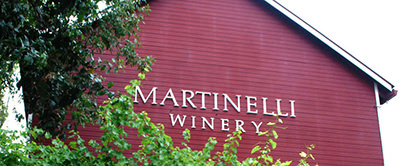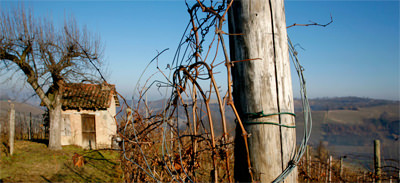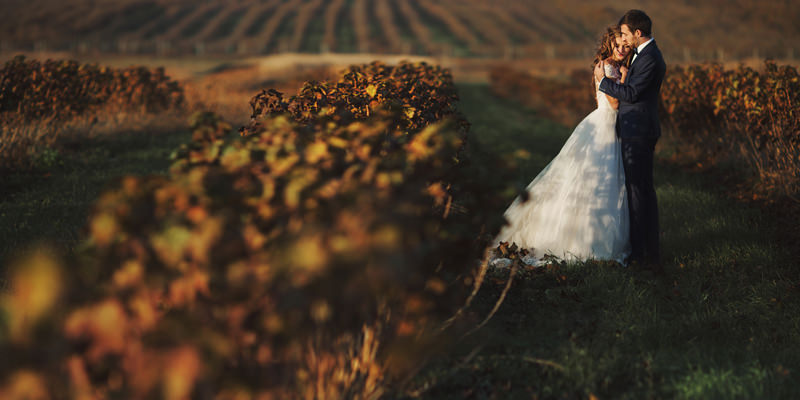The origins of Valentine’s Day as a romantic holiday are debatable, but here’s a solid theory: whether single or coupled up, by February 14th, everyone needs a good love story. February is the shortest month of the year, but it’s also filled with dark days and frigid, face-numbing cold. Fluffy snow is now dirty slush, and despite the groundhog’s report, spring doesn’t seem to be getting any closer. Sure, there are romance novels and rom-coms and Ryan Gosling (yes, please!) to curl up with, but sometimes love stories pop up in the most unexpected of places – like in a wine bottle, for instance. These two wineries, along with their wines, wouldn’t exist if it weren’t for some Lifetime movie-worthy romances. Not only will they have you in the mood to snuggle up on the couch, but they’ll give you something to drink while you do.
Martinelli Winery

At Sonoma’s Martinelli Winery, family and winery history are one in the same, and the Martinellis have a slew of love stories in their family folklore. It all started not in the U.S., but in Italy, where, in the late 1800s, 19-year-old Giuseppe Martinelli fell in love with 16-year-old Luisa Vellutini. But when the Tuscan winemaker declared his intention to marry Luisa, his family decried the wedding, declaring that Luisa was of an improper social class. Determined to be together, the young couple left behind their homes and families and eloped to California’s Russian River Valley. Here, Giuseppe worked in vineyards until he had saved up enough money to buy his own land that happened to include the famed Jackass Hill, which remains to this day the core of Martinelli’s vineyards. Working side-by-side, both literally and metaphorically, Luisa and Giuseppe planted Zinfandel and Muscat of Alexandria vines, beginning the Martinelli legacy. As Giuseppe sold grapes and wine in San Francisco (via horse and surrey!), Luisa pruned vines, cared for their children, and even took to shooting wild turkey and quail, putting dinner on the table for the family upon Giuseppe’s return.
Sadly, Giuseppe passed when their youngest son, Leno, was just twelve years old. Being over a decade younger than his siblings, Leno was given the least enviable piece of his father’s land: the steep (so steep “only a jackass would farm it,” hence the name) Jackass Hill. Each subsequent generation of Martinelli children began working in these vineyards by the age of 6 or 7, including Leno’s son, Lee Sr., who furthered the family business through a love story of his own. After spotting Carolyn Charles on his college campus, Lee asked a friend to set him up with “that tall blonde,” only to arrive to meet his date and discover that his friend had set him up with the wrong tall blonde. So he asked another friend, and another, and after failing to be set up with his dream woman three or four times, Lee still wouldn’t give up. Luckily, fate stepped in, and the following semester, Carolyn happened to walk into Lee’s classroom. After a wink from Lee – and perhaps helped by the copious amounts of Muscat of Alexandria dessert wine that Lee’s parents poured for Carolyn upon meeting them for the first time – Carolyn was smitten. (Cue “Drunk In Love” here). It was Carolyn’s side of the family that brought Sonoma Coast land into the Martinelli legacy; Lee helped George Charles, Carolyn’s father, tend to his land, which was then a sheep farm. Inspired by the Martinelli family’s connection to wine, George planted vines on his land, which later became the Charles Ranch Vineyard and now makes essential Martinelli wines, along with Martinelli’s other Sonoma Coast land.
Wine to love: 2012 Martinelli ‘Three Sisters Vineyard’ Chardonnay, Fort Ross-Seaview (Sonoma Coast)
Along with Zinfandel, Syrah, and Pinot Noir, Martinelli makes a range of single-vineyard Chardonnays that each speak to their individual place of origin. This vineyard came into the family from Carolyn’s side and is in fact still owned by Carolyn and her two sisters – hence the ‘Three Sisters Vineyard.’ Flirtatious, this Chardonnay plays coy on the nose, only to reveal succulent, luscious flavors on the palate. Vanilla and spice are present, from the wine’s oak-aging, but more than that, the bright lemon curd, red apple, and high-toned minerality speak more to the cool, coastal region in which this wine is made, with the warmth of the family from which is comes.
Hilberg-Pasquero
 In the land of family-named wineries such as Mascarello, Conterno, and Viberti, “Hilberg” seems to be a bit out of place, but for good reason: an international love story is to blame. Founded in the early 1900s, the Pasquero farm has long produced an assortment of crops in the village of Priocca, just a few miles northwest of Barbaresco in Piedmont. However, the family never produced wine commercially. Third-generation Michelangelo Pasquero – known as Miklo to his friends – took particular interest in the family business and decided, after his university studies, to travel to Sweden and Germany to discover new organic farming practices.
In the land of family-named wineries such as Mascarello, Conterno, and Viberti, “Hilberg” seems to be a bit out of place, but for good reason: an international love story is to blame. Founded in the early 1900s, the Pasquero farm has long produced an assortment of crops in the village of Priocca, just a few miles northwest of Barbaresco in Piedmont. However, the family never produced wine commercially. Third-generation Michelangelo Pasquero – known as Miklo to his friends – took particular interest in the family business and decided, after his university studies, to travel to Sweden and Germany to discover new organic farming practices.
What he didn’t expect to discover was German national Annette Hilberg, a professional nurse with a passion for organic products. After – glamorously – beginning their relationship among bean fields, the smitten couple moved back to Miklo’s homestead at the Pasquero farm, Annette leaving her job and life in Germany to be with Miklo. Despite being an outsider, Annette worked alongside the Piedmontese people, learning the local dialect and eventually succeeding in becoming fully accepted into the local culture.
With Miklo and Annette at the helm of the Pasquero farm in the late 80s and early 90s, they decided to start making wine, as the organic food market was not very developed at the time. Thus, in 1994 the Hilberg-Pasquero winery was born, making Nebbiolo, Barbera, and Brachetto as single-varietal and blended wines. The couple’s only regret is that they didn’t save any bottles from their inaugural vintage – but everything else seems to have ended happily ever after.
Wine to love: 2009 Hilberg-Pasquero Barbera d’Alba Superiore, Piedmont
While Barbera may be almost as well-known as Pinot Noir these days, we’d put money on the fact that you’ve never had a Barbera like this. This is a serious, complex, so-freaking-delicious Barbera that just might make you fall in love on the spot. At first it’s like diving into depths of black cherry and sweet spice, and then layers upon layers of tobacco, smoke, violet, thyme, and wet earth descend and envelop. This is Barbera for Barolo lovers.

